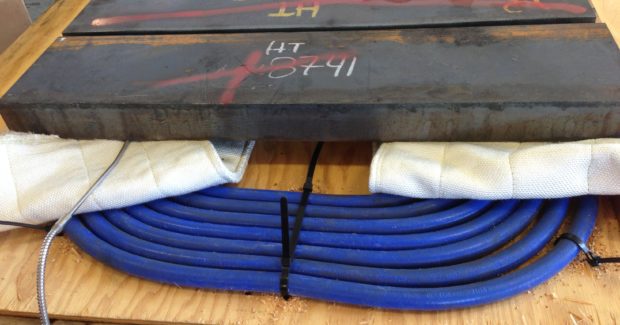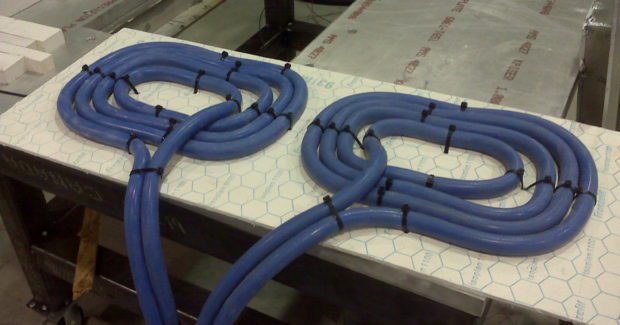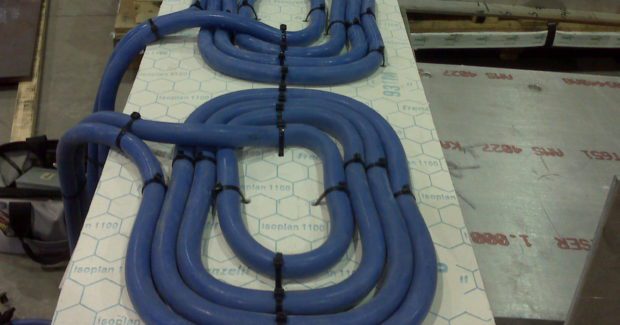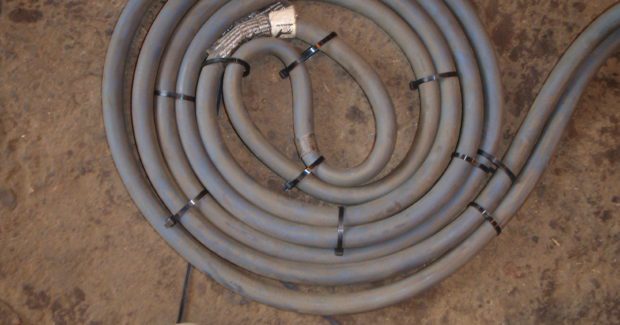Think Induction Heating Is Only for Pipe Welding? Think Again
Widely used for pipe welding, induction heating is also a flexible option for flat plate welding and other applications that involve a wide range of part sizes and geometries and heating requirements.
Posted: December 21, 2016
Induction technology offers numerous benefits in many welding applications that require preheating and stress relieving of parts. Induction provides great consistency in heating, faster time to temperature of the part, ease of use and safety in operation. While induction is a commonly used method for heat treatment in pipe fabrication and welding, many people may not realize that this method also offers great flexibility and benefits in welding applications involving other part geometries, including flat plates. To help dispel the notion that induction can be used only for pipe welding, this article discusses some key best practices to help operations achieve success when using induction heating in flat plate applications.
THE EFFICIENCY OF INDUCTION
Induction heating is a power source-driven heating process that quickly brings a part to temperature and holds it there. It offers advantages for safety, quality and efficiency that are not found in other heating methods, such as open flame and resistance heating. Induction heating systems quickly heat conductive metals by inducing current into the part. Induction does not rely on a heating element or flame to transfer heat. Instead, an alternating current passes through the heating device, creating a magnetic field around it. As the magnetic field passes through the workpiece, it creates eddy currents within the part. The resistance of the metal fights against the flow of the eddy currents, generating heat in the part. The part becomes its own heating element, heating from within, which makes induction very efficient since little heat is lost in the process.
Applications that typically require hours to heat can be completed in minutes by utilizing induction heating and the different liquid-cooled, air-cooled and rolling options. Because induction heating systems can use various components to induce heat, depending on the part size and geometry, this makes them a very flexible option.
A FLEXIBLE OPTION FOR FLAT PLATE
The need to weld flat plates or flat components is common in many industries, including for equipment repair in mining, beam welding in structural steel, bridgework, and shipyards and barges. In flat plate applications that require preheating or post-weld stress relief, operations may be using a torch or open flame heating to bring the part to temperature. The flame method can pose heating consistency challenges – especially on large or very thick workpieces – and also in difficult weather conditions on outdoor jobsites, such as wind or rain. In contrast, induction is an option that offers heating consistency in many conditions, flexibility for varying part sizes and shapes, quick time to temperature, and ease of use. It can be used on very thick steel beams, on large workpieces and in small, confined spaces. It also offers ease of use no matter the weather conditions – wind and rain won’t interfere with induction the way they can with flame – as well as safety benefits compared to flame heating.
In addition, induction heating systems available today offer options for accommodating differing part geometries. There are various induction coil configurations available that sit on top of a plate and don’t have to be wrapped around the piece. In induction coil design, a solenoid or helix coil is one that is typically wrapped around the part, while a pancake coil (which looks similar in shape to a stovetop heating element) can lay flat on the part and be stretched out to cover a large area. In flat plate applications, operators will typically use a pancake coil or an induction blanket. Induction coils can be shaped to fit small, confined areas, and they also can be spread over a large area to bring a larger workpiece up to temperature. For example, one long coil can be used to heat a 40 ft steel beam. In addition, insulation or magnetic clamps can be used to hold the pancake coil against the flat plate, which is useful in applications where the workpiece is vertical.
It’s also important to note that induction coil configurations can be used to heat from one side of the part – and heat the entire part – in flat plate welding applications. So, for example, if the welding operator is working on one side of the plate, the induction coil can be heating from the opposite side. This allows induction heating and welding to occur at the same time, while also saving time in setup and in moving on to the next part. It also provides benefits for operator comfort.
EASY DOCUMENTATION OF TEMPERATURES
Induction heating systems are now available that offer digital recording capabilities that allow temperature levels to be easily tracked and documented. This is important in many welding applications when it’s critical for quality assurance to ensure that code requirements or customer specifications regarding heat treatment temperatures are being met. The capability to digitally record this information provides greater ease of use, efficiency and accuracy compared to recording this data by hand. Even in situations where documentation of temperature levels is not required, this option can provide welding operations with a competitive advantage, since they have the ability to prove to customers that the proper temperature levels were used in heat treating.
TIPS AND BEST PRACTICES
When using induction for heat treatment in welding applications, there are a few best practices to keep in mind that can help ensure success.
- Winding the coil: Take the time to properly wind the coil on the part. Improper winding of the coil can result in not having enough power for the heating requirements. For the best results, the turns of the coil should all be in the same direction, either all clockwise or all counterclockwise, for example. Avoid coil turns that are a 180 deg angle or in zig-zag configurations. In addition, any unused portion of the coil – such as the ends – should be twisted together or tied together with tie-wraps, tape, rope or string to reduce the amount of heat losses in the unused portion of coil.
- Thermocouple placement: With open-flame heating, temperatures are monitored manually using temperature crayons. In contrast, induction heating systems have a built-in heat controller to monitor temperatures using feedback from thermocouples mounted on the piece. The thermocouple feedback to the machine controls the machine’s power, to help prevent overheating. This makes thermocouple placement critical to achieving the desired temperature levels. It typically works best to have the thermocouple toward the center of a coil configuration, which tends to be the warmest spot. For best results, thermocouples should be placed underneath the blanket. This prevents overheating and potential damage to the induction heating coil. Also, the thermocouple should be placed underneath the blanket coils rather than under the middle of the blanket, which is actually a cooler area. This helps ensure accuracy in temperature readings. On plate corners and edges, be aware that coils that go over a corner or an edge can heat those areas up to a much higher temperature.
- Proper temperature settings: It’s important to note that some applications may require going above the desired setpoint temperature in order to achieve the proper temperature at the root of the weld. This allows for some losses as the system heats the thickness of the part. For example, in an application that calls for preheat to 250 deg F, it can be beneficial to set the surface temperature up to 300 deg or 325 deg – especially on thicker materials or when induction is only used on one side of the workpiece – to ensure the minimum preheat temperature is reached throughout the part. With many types of steel there is a wide minimum-to-maximum temperature window, so exceeding the maximum interpass temperature level is typically not an issue.
THINK BEYOND PIPE
Induction heating is a feasible option in many welding applications that provides significant benefits, including more consistent heating, faster time to temperature and improved safety. As a result, projects can be completed faster without impacting quality or operator safety. While this heating method is well known and becoming more widely used for pipe welding applications, it also offers benefits in many other applications as well, including flat plate welding. Available systems offer various types and styles of components to induce heat in parts, making induction a flexible option for applications that involve a wide range of part sizes and geometries and heating requirements.



















